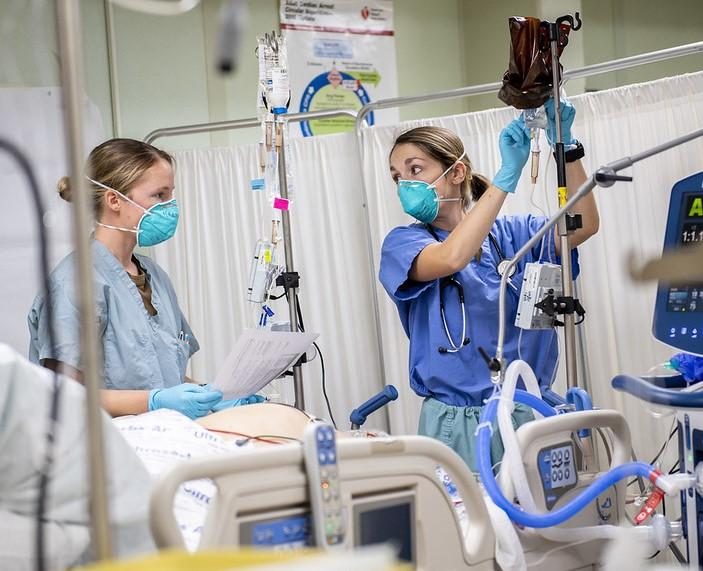Implementation of ventilation standards of at least five clean-air changes per hour, COVID-19 testing, the use of personal protective equipment (PPE), and universal wearing of respirators prevented most SARS-CoV-2 transmissions in a California healthcare system from 2020 to 2022, suggests a study published yesterday in Clinical Infectious Diseases.
For the study, University of California (UC) researchers used electronic health records and movement data of patients and staff to conduct viral genomic and social network analyses to estimate COVID-19 spread in the UC–San Diego Health system. The team analyzed 12,933 viral genomes from 35,666 infected patients and healthcare workers (HCWs) (out of 1,303,622 tests [2.7%]) from November 2020 to January 2022.
Testing, PPE, respiratory protection
HCWs were required to wear N95 respirators, eye protection, gowns, and gloves while directly caring for COVID-19 patients and were asked to don KN95 or N95 respirators in all hospital areas, including non–patient-care areas.
All unvaccinated HCWs underwent COVID-19 testing twice weekly, and vaccinated HCWs were tested weekly during periods of increased community transmission. Each HCW completed a daily COVID-19 symptom survey and were referred for testing if they reported a positive symptom or exposure.
Patients were tested at admission and on day 3 of hospitalization and were asked to mask while within 6 feet of another person, but the authors noted inconsistent compliance. Owing to a limited number of negative-pressure rooms, COVID-19 patients were not always placed in these rooms, and patients room doors were often kept open to enable direct observation.
Patients in shared rooms more vulnerable
Of the 5,112 SARS-CoV-2 viral samples sequenced from the second and third pandemic waves (pre-Omicron variant era), 291 patient or HCW interactions may have involved a healthcare exposure. Thirty-four of the 291 pairs (12%) were genetically linked, with 19 attributable to household transmission and 14 to healthcare spread.
In December 2021 and January 2022 (Omicron period), 1,376 HCWs tested positive for COVID-19, up over 800% from the previous 2 months. At the peak of this wave, as many as 257 HCWs tested positive each day. During this time, 2,106 contact pairs from 7,821 genetic sequences identified 120 (6%) related pairs among 32 clusters, of which 10 were likely healthcare-related.
Spread was more likely to occur in shared spaces in the older Hillcrest campus during the second and third waves amid Omicron than in the newer La Jolla campus, which has mainly single-occupancy patient rooms.
Of the remaining 20 pairs, 19 were linked to shared households, and the infections in two patients involved no meaningful contact within the healthcare system from their self-report of dates worked. The two interacted only with each other 24 hours before testing positive, suggesting previous community acquisition.
Spread was more likely to occur in shared spaces in the older Hillcrest campus (11 contact pairs [79%]) during the second and third waves and 18 pairs (75%) amid Omicron than in the newer La Jolla campus, which has mainly single-occupancy patient rooms (3 pairs [21%] and 5 pairs [21%], respectively; 2.5 vs 0.6 transmission events per 1,000 admissions).
Thirty-nine HCWs and patients were part of likely transmission events at Hillcrest, compared with 13 at La Jolla. The rate of transmissions per 1,000 admissions was 2.54 at Hillcrest, compared with 0.63 at La Jolla. Also, most patients who either acquired or spread the virus in the hospital were in a shared room during part of their stay (6 of 6 patients during the second and third waves of SARS-CoV-2; 4 of 6 amid Omicron).
Most spread occurred outside hospital
The authors said that hospital infection-control measures were effective in stemming and helping identify cases of COVID-19 transmission.
"Even when hundreds of health care workers were becoming infected every week during the peak of the Omicron wave, we found that they were no more likely to acquire the virus in the hospital system," co-senior author Joel Wertheim, PhD, said in a UC–San Diego news release.
In fact, most transmission occurred outside of the healthcare setting, in the community, between households, or when universal masking was not followed. Viral transmission was more likely to occur in shared spaces, such as breakrooms or lobbies, according to the release.
"However, given that there are inevitable lapses in adherence to infection prevention protocols, healthcare facilities could further benefit by expanding mitigation measures, including enhancing ventilation and air exchanges in all spaces during a future respiratory virus pandemic and supporting single occupancy rooms," the authors concluded.



















